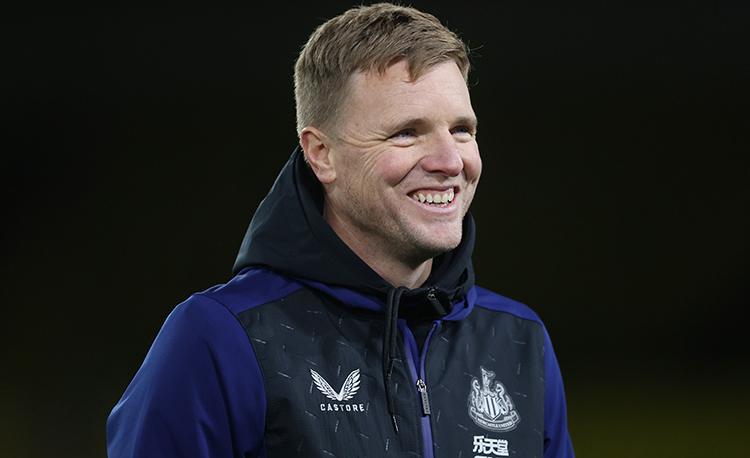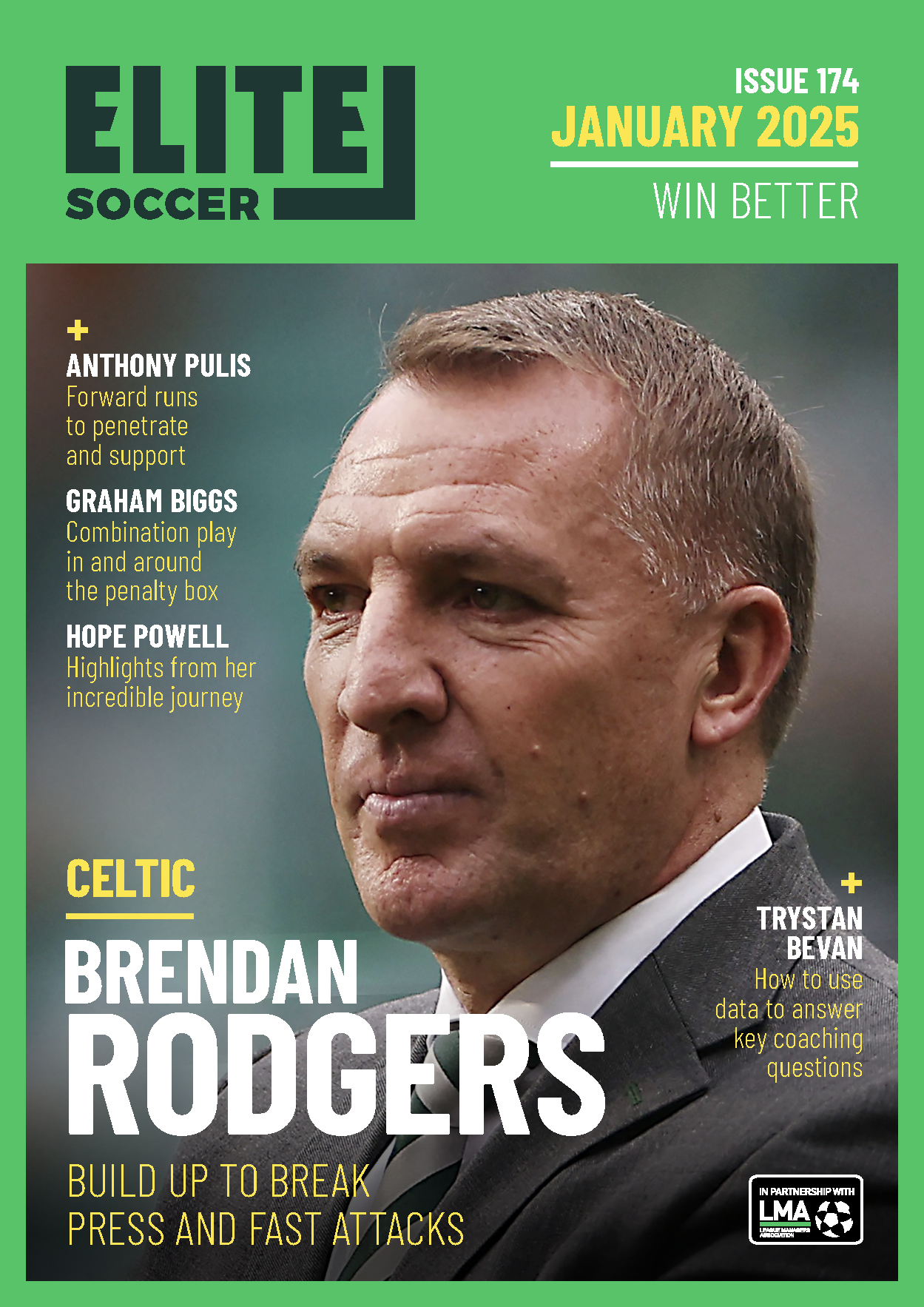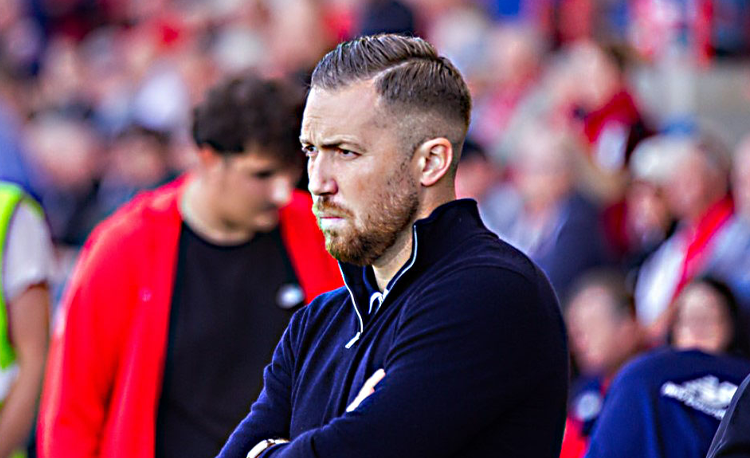You are viewing 1 of your 1 free articles
Switching play
| Area | Up to full pitch |
| Equipment | Balls, bibs, cones, 3 full size goals |
| No. of Players | Up to 20 players + 3 goalkeepers |
| Session Time | Passing and switching drill: 15mins Back to Back goals game: 20mins Three goal game: 15mins |
This session is made up of three activities, each with a switch of play featured as part of its make-up.
The session starts with a passing drill that works on subtle movements and it teaches players to open up their bodies to attack the weak side of the pitch through good technical combination play. We would run it in three phases – a basic drill followed by two progressions. We would use this activity once every two weeks depending on what we feel would benefit our game or the individuals in the team.
We continue the session with a possession game incorporating a switch of play through the zones. This can be done either by making short or long passes. The game also has a defending element, with the out-of-possession team looking to win the ball to score while under a reaction press from the team who conceded possession. I like this activity because it encourages the team on the ball to be composed under pressure while also reacting to a turnover of possession, which means going from expansive play to compactness and working as a team. We would run this quite often if we are looking at different elements in the lead up to a game where we want an effective switch of play and different points of attack.
The final activity of the session is all about using switches of play to change the point of attack to put pressure on the opposition’s weaker side. We would run this activity at the end of a session whenever we feel we need to improve our weak-side play.
“This session is made up of three activities, each with a switch of play featured as part of its make-up”
PASSING AND SWITCHING DRILL
We would run this passing drill after a warm-up [not shown] to engage the players technically as well as physically and it will prepare them for the rest of the session. The players get lots of touches of the ball and are able to work on different receiving skills. We would run it in three phases – the basic drill and two progressions.
We set up a playing area of 30x20 yards. We’re using seven outfield players: two in the middle of the area and one on each corner, except for the starting corner where there are always two player. We limit the players to two touches.
The ball starts in the bottom right corner – the player passes across the bottom of the area and follows the pass. The receiving player passes the ball to a player in the middle and follows the pass. The player in the middle plays the ball out diagonally the other way and follows the pass. The passing continues in a figure of eight shape for two minutes, as shown [1a].
[1a]

- The ball starts in the bottom right corner. The player passes the ball across the bottom of the area and follows the pass
- The receiving player passes the ball to a player in the middle and follows the pass
- The player in the middle plays the ball out diagonally the other way and follows the pass
- The passing continues in a figure of eight shape for two minutes. Then reset with two players at the top left corner and run the same passing pattern in the opposite direction starting from the top left
“Players again follow their pass and must maintain the intensity by judging how best to receive the variety of passes”
Players reset and the drill then runs the other way, starting from the top left of the area, where there are two players. We would run this for another two minutes.
To progress the drill, the players then reset, starting from the bottom right corner again and a different passing pattern is used, as shown [1b].
[1b]
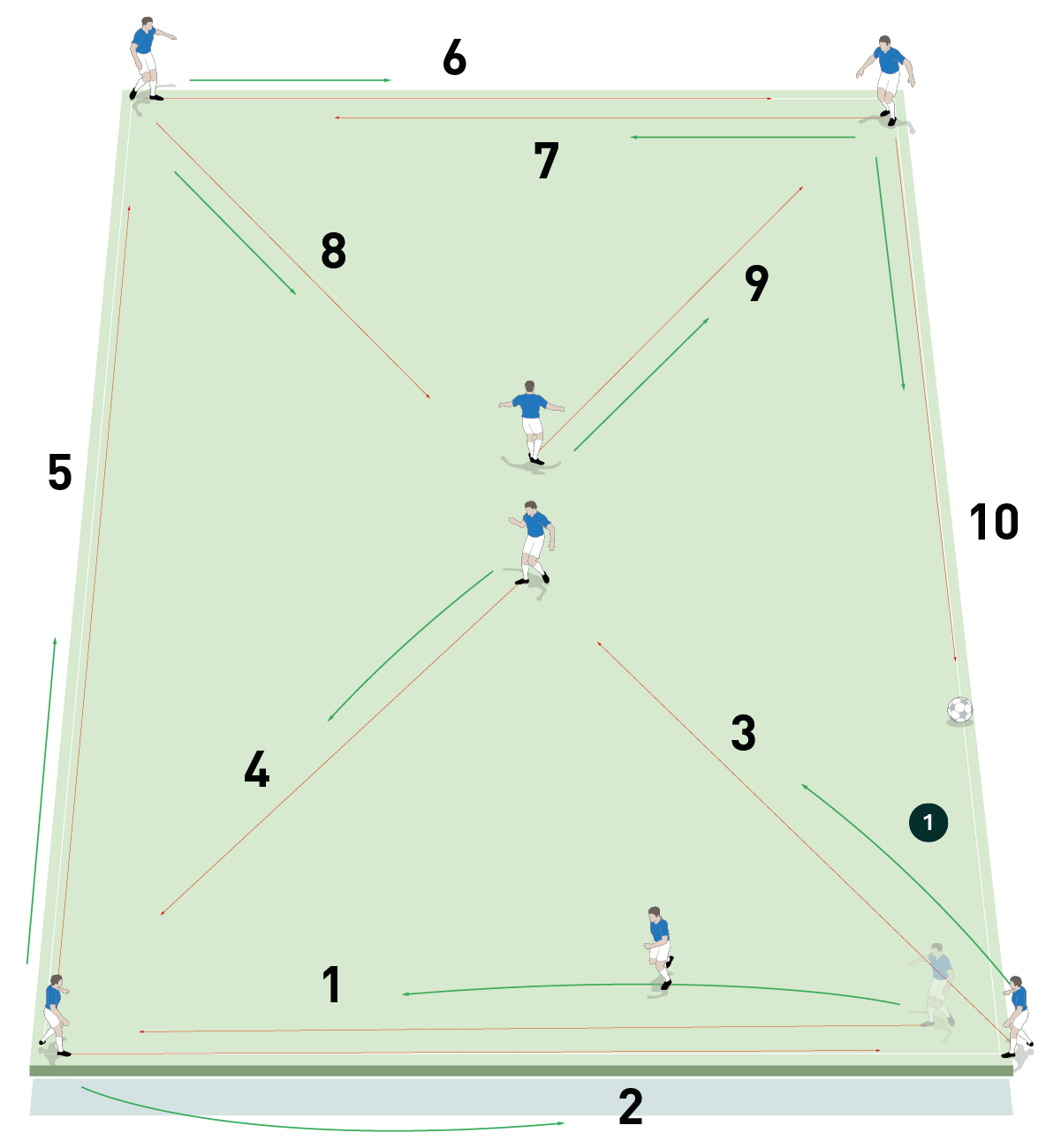
- Players reset with the ball starting from the bottom right corner again and a different passing pattern is used. Players follow their pass. After two minutes, players reset and run the same passing pattern in the opposite direction
Players again follow their pass and must maintain the intensity by judging how best to receive the variety of passes. After two minutes the players reset and the drill runs in the opposite direction.
To progress the drill further, the players then reset and start from the bottom right corner again, with a central combination introduced this time. The starting player passes the ball across the bottom and follows their pass. The receiving player passes the ball to a player in the middle and follows their pass. The players in the middle combine, with one making a short pass to the other and then making a run to receive it back, before playing the ball out diagonally. The ball is then played across the top of the area and back into the middle, where the two central players combine in the same way again before passing diagonally back to where the ball started, as shown [1c]. Players follow their pass.
[1c]

- To progress the drill further, the players reset. The starting player passes across the bottom of the area. Players follow their pass
- The receiving player passes the ball to a player in the middle and follows the pass
- The two players in the middle combine, with one passing short to the other and making a run to receive it back, before playing the ball out diagonally
- The ball is played across the top of the area and back into the middle where the centre players combine in the same manner as before and pass it out diagonally back to where the ball started
We use the initial drill to build intensity in the first phase. Then in the progression we would work with the players on their body shape to receive, creating the intensity through getting players to appreciate the pass, while the final progression is aimed at encouraging the players to make subtle movements to create space.
If any of the phases break down, it is often due to the individual not setting correctly, or the players using the wrong body shape and failing to appreciate the pass. This is when the coaches would step in to address the group.
BACK TO BACK GOAL GAME WITH A SWITCH
We set up a playing area of 66x56 yards, split into four quarters. Two goals are positioned back-to-back in the centre of the area on the halfway line, each with
a goalkeeper.
We’re using 18 outfield players split into two teams of eight and two floaters who play for the team in possession. Both teams have two players starting in each box although they are free to move from box to box. One floater starts in each half.
The blues begin as the attacking team, as shown [2a], and they must try to pass to keep the ball using the overload given to them by the floaters.
[2a]

- The blues begin as the attacking team and they start with two players in each of the four boxes. There is no restriction on movement
- The reds also start with two players in each box and they are the defending team
- The yellows start with one in each half. They are floaters who support the team in possession
- Both goalkeepers can also support the attacking team and can help them to keep the ball
To keep possession they can also use the support of both keepers if needed and by using clever switches of play – both long and short, as shown [2b].
[2b]

- To keep possession the blues must make the playing area as big as possible by using clever switches of play – both long and short passes. Here the blues make a long switch
- Every time the blues switch the play across the halfway line, they receive two points
- The reds press to try and win possession
To ensure the team keeps possession, players must understand when to make short switches of play and when to make long switches.
Every time the ball crosses the halfway line, the blue team receives two points. If the ball goes out of play, a coach serves the ball back in for a restart with the same team on the ball and in possession again.
The reds begin as the defending team and they must press to try to win possession. If the red team wins the ball, the objective is to quickly score in the nearest of the goals. The blues must counter-press to try to regain possession and should work as a team to become compact if they are going to prevent the reds from scoring. If the red team scores a goal, they get five points and switch roles to become the new possession team, as shown [2c].
[2c]

- If the red defending team wins the ball, they quickly try to score in the nearest of the goals. They get five points for scoring in the goal
- The blues must counter-press to try to regain possession and should work as a team to become compact and to prevent the reds from scoring
As coaches, we should be aware that the session could break down if the possession team is not encouraged to use all four grids. They need to make the area as big as possible so it is easier to switch play while remaining composed.
We play four games of four minutes. In game one, players are all-in; in games two and three, players are limited to two touches; in game four players are limited to one-touch except the floaters and the keepers who are all-in.
THREE GOAL GAME
We set up a playing area on a full-size pitch using the whole width. The length of the playing area is from the goal line at one end to the edge of the penalty box at the other. A goal is positioned in its regular position in the penalty box, and two goals are placed at the opposite end on the corners of the penalty box, as shown [3a]. There is a goalkeeper in each of the goals.
“When the ball is played into their attacking half, the blues must switch the play to the opposite side of the pitch before they can score”
[3a]
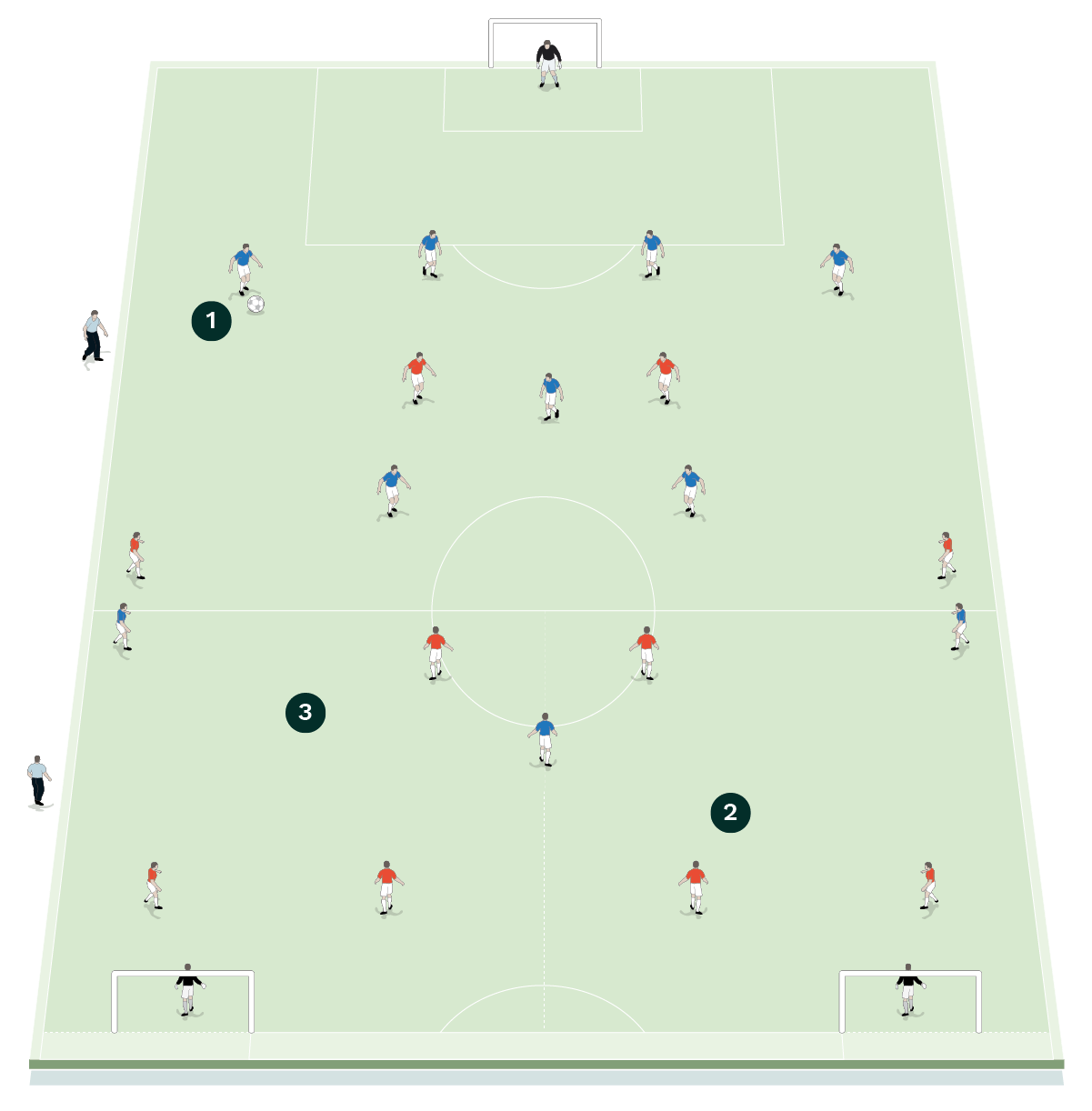
- The blue team is set up in a 4-3-3 formation and they start in possession
- The red team is set up in a 4-4-2 formation
- The shorter end of the pitch has two goals and is split into two zones
The shorter half is separated into two zones with a line marked down the centre. Balls are placed around the pitch for quick restarts and offsides apply to both teams.
We’re using 20 outfield players split into two teams of ten. The blue team is in a 4-3-3 formation and the red team is in a 4-4-2 formation.
We play four games of five minutes. Both teams defend and attack twice each, changing shape accordingly.
The blue team starts with the ball and they attack the two goals at the shorter end of the pitch, playing out from the back and working on build up patterns of play. When the ball is played into their attacking half, the blues must switch the play to the zone on the opposite side of the pitch before the team can score, as shown [3b]. The ball can be switched multiple times before scoring.
[3b]

- The blue team starts by playing out from the back and working on build up patterns of play
- The reds press and try to win the ball
- When the ball is played into their attacking half, the blues must switch the play into the zone on the opposite side of the pitch before they can score
- The blues must try and score in one of the two goals at the shorter end of the pitch
If the red team wins the ball back, they must counter-attack the single goal at the longer end of the pitch. The blue team must quickly react by counter-pressing and trying to win the ball back, recovering into shape as quickly as possible, as shown [3c].
[3c]

- The red team press and if they win possession they must counter-attack the single goal at the longer end of the pitch
- The blue team must quickly react to losing possession by counter-pressing, regaining their shape and trying to win the ball back
One coach manages one team, while another coach manages the other team and if needed we would talk tactically to the respective teams to highlight the positives and negatives of their play and discuss what they can do to improve.
We would play four games of three minutes.
Related Files
Editor's Picks
Using the goalkeeper in build-up play
Pressing principles
Intensive boxes drill with goals
Penetrating the final third
Creating and finishing
My philosophy
Pressing initiation
Compact team movement
Defensive organisation
Coaches' Testimonials

Alan Pardew

Arsène Wenger

Brendan Rodgers

Carlos Carvalhal

José Mourinho

Jürgen Klopp

Pep Guardiola

Roy Hodgson

Sir Alex Ferguson

Steven Gerrard
Coaches' Testimonials

Gerald Kearney, Downtown Las Vegas Soccer Club

Paul Butler, Florida, USA

Rick Shields, Springboro, USA

Tony Green, Pierrefonds Titans, Quebec, Canada
Join the world's leading coaches and managers and discover for yourself one of the best kept secrets in coaching. No other training tool on the planet is written or read by the calibre of names you’ll find in Elite Soccer.
In a recent survey 92% of subscribers said Elite Soccer makes them more confident, 89% said it makes them a more effective coach and 91% said it makes them more inspired.
Get Monthly Inspiration
All the latest techniques and approaches
Since 2010 Elite Soccer has given subscribers exclusive insight into the training ground practices of the world’s best coaches. Published in partnership with the League Managers Association we have unparalleled access to the leading lights in the English leagues, as well as a host of international managers.
Elite Soccer exclusively features sessions written by the coaches themselves. There are no observed sessions and no sessions “in the style of”, just first-hand advice delivered direct to you from the coach.
